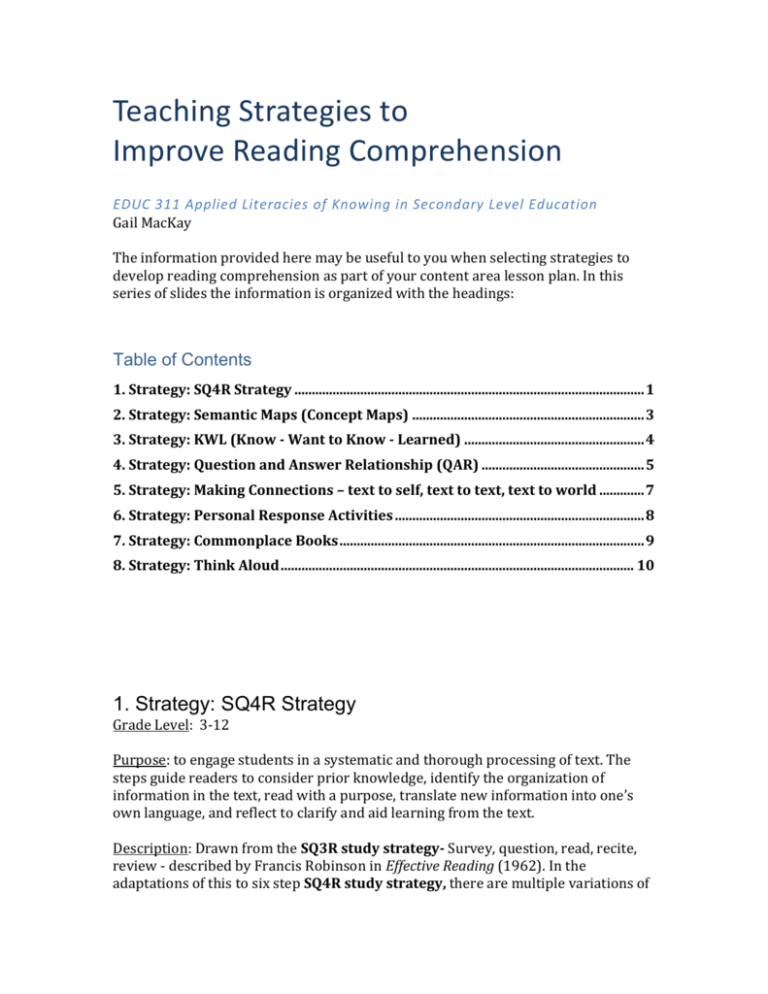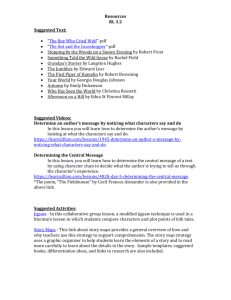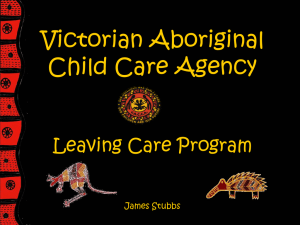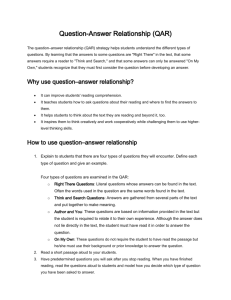Week 8 Teaching Strategies to improve Reading
advertisement

Teaching Strategies to Improve Reading Comprehension EDUC 311 Applied Literacies of Knowing in Secondary Level Education Gail MacKay The information provided here may be useful to you when selecting strategies to develop reading comprehension as part of your content area lesson plan. In this series of slides the information is organized with the headings: Table of Contents 1. Strategy: SQ4R Strategy ..................................................................................................... 1 2. Strategy: Semantic Maps (Concept Maps) ................................................................... 3 3. Strategy: KWL (Know - Want to Know - Learned) .................................................... 4 4. Strategy: Question and Answer Relationship (QAR) ............................................... 5 5. Strategy: Making Connections – text to self, text to text, text to world ............. 7 6. Strategy: Personal Response Activities ........................................................................ 8 7. Strategy: Commonplace Books ........................................................................................ 9 8. Strategy: Think Aloud ...................................................................................................... 10 1. Strategy: SQ4R Strategy Grade Level: 3-12 Purpose: to engage students in a systematic and thorough processing of text. The steps guide readers to consider prior knowledge, identify the organization of information in the text, read with a purpose, translate new information into one’s own language, and reflect to clarify and aid learning from the text. Description: Drawn from the SQ3R study strategy- Survey, question, read, recite, review - described by Francis Robinson in Effective Reading (1962). In the adaptations of this to six step SQ4R study strategy, there are multiple variations of the R steps – respond, record, represent, reflect. Here is the one presented by Tomkins, Bright and Winsor: 1. Survey – … reader scans and skims the text to get overview of the content and message: taking note of features that organize information such as titles, abstract, summary, headings, sub-headings, illustrations, graphs, maps, boxes etc. 2. Question- …reader poses questions of the text, by converting the headings and subheadings into questions 3. Read – … reader reads the entire text section to answer the questions posed 4. Recite - …. reader states answers to the questions to self or to reading partner 5. Review – reader goes back over reading summaries or other features of the text that capture the highlights of the text, rereading where necessary 6. Reflect – the reader makes a reading/writing connection, by thinking about the text, writing their understanding or interpretation. Possibilities are a) journal entry, or b) two column chart for writing notes STATEMENT in first– INTERPRETATION in second, or c) notes using the headings or questions to clarify and aid memory of the learning from the text. Procedure: it is best if teachers provide step by step guidance for each of the six stages of this strategy. Teach the step, model the step, and give students practice with the step. IT TAKES TIME, in order for them to learn to use the strategy. Do not try to cover all of it in one lesson, especially in the middle years. Here are some sources for the SQ4R for university level study http://www.jccc.edu/files/pdf/academics/aac/sq4r-study-method.pdf http://www.lib.uoguelph.ca/get-assistance/studying/effective-studying/sq4rstudying http://www.yorku.ca/spark/effective_reading_strategies/sq4r_reading_strategies_s q4r_reading_strategies.html SQ4R work sheets. A detailed exercise sheet to have students demonstrate the completion of each step https://www.bakersfieldcollege.edu/sites/bakersfieldcollege.edu/files/SQ4RPractice-Worksheet.pdf. This is a bit tedious and perhaps too detailed. You can adapt it and use part of it for your lesson plan. References: Booth Olson, C. (2011) The Reading/Writing Connection: Strategies for Teaching and Learning in the Secondary Classroom, (3rd ed.). Boston: Pearson Robinson, Francis Pleasant (1978). Effective Study (6th ed.). New York: Harper & Row. 2. Strategy: Semantic Maps (Concept Maps) Grade Level: 3-12 Purpose: To guide students’ identification of major and minor ideas and the logical connections between ideas. Description: Semantic map is a basic graphic organizer that connects the main ideas to subordinate information. As ateaching tool, a semantic map can help the learner to understand new vocabulary, to identify the structure of a text, or to synthesize learning and to solve problems. Semantic maps can be used in 1) a pre-reading activity to build vocabulary; 2) at the beginning of a unit to structure inquiry; or 3) at the conclusion of a reading to summarize comprehension At its most basic level, a semantic map shows the relationships between words and new vocabulary. At a more advanced level, a semantic maps can show the logical relationship between concepts and ideas. The semantic map shows the key parts and the whole all at once to organize the relationships between ideas. Semantic maps help the learner to understand the text and to solve problems. A simple semantic map has three basic components 1. Core concept or question-The question or concept as a main focus. All ideas are related in some way to the core question or concept eg. ‘Bullying” 2. Strands – The subordinate ideas generated by Ss to help clarify the concept eg. i, The Victim, ii The Bully, iii The Bystander, 3. Supports – Details, inferences, generalizations related to the strand. These give detail about the strand, and distinguish one strand from another. e.g i. Behaviour that stops bullying, ii behaviour that continues bullying See Vacca, Vacca & Mraz (2014) p. 326 “Semantic (Cognitive Mapping)” A sample lesson using sematic map to teach vocabulary http://www.azed.gov/english-language-learners/files/2014/02/semanticmapping-lesson.pdf Examples of generic forms of graphic organizers that could be used in content areas to structure inquiry and reading comprehension. (see Vacca, Vacca & Mraz, p 419) 1. a definition with examples and illustrations: Spider Map 2. process, stages or series of events: Series of Events Chain 3. a continuum or scale of time, ages, shades of meaning, any rated measure of criteria: Continuum/Scale 4. comparison and contrast: Compare/Contrast Matrix 5. problem, attempted solution and results: Problem/Solution Outline 6. cause and effect: Network Tree 7. nature of human interaction : Human Interaction Outline 8. causal interaction of complex phenomena: Fishbone Map 9. a series of events leading to a set result: Cycle Procedure: Steps to develop vocabulary with elementary grades 1. Identify the Main Topic (supra ordinate category) 2. In a column list important words from what is already known 3. Order & categorize the words as Strands (subordinate), Supports (sub-subordinate) 4. Evaluate the organizer – what are the relationships between the ideas? What is it we already know? Is there something more that we want to learn? 5. Read and relate new information (words) within the categories, add new categories if needed 6. Have students work in groups 7. Add vocabulary and categories to main map that is visible to all students. Steps to build a semantic map to summarize reading a text. 1. Identify main ideas, use heading and subheadings 2. Make connections between main ideas 3. Identify supporting, or subordinate ideas, link observations and experiential learning to this 4. Draw a graphic organizer to represent the connections between the ideas. References: Booth Olson, C. (2011) The Reading/Writing Connection: Strategies for Teaching and Learning in the Secondary Classroom, (3rd ed.). Boston: Pearson. Fishbone Map of Cause and Effect http://www.readwritethink.org/files/resources/lesson_images/lesson277/s ample.pdf Word Knowledge Sample Lesson: Semantic Mapping. The Reading Teacher’s Sourcebook. http://www.azed.gov/english-languagelearners/files/2014/02/semantic-mapping-lesson.pdf 3. Strategy: KWL (Know - Want to Know - Learned) Grade Level: 3-12 Purpose: to prompt readers to access cognitive strategies, and emphasize strategic behaviour, and develop readers into strategic comprehenders. (Duffy, 2002; 30). KW-L strategy guides students to tap prior knowledge; make connections between what they already know and the information that will be presented in the text. Description: Have students focus on the metacognitive processing of information. Help them become aware of what they know of a subject, what they would like to know about the topic or from the text, and what they learned. Procedure: 1. Introduce the strategy by explaining the topic to be addressed in the text. 2. Have students brainstorm what they already know about the topic and record their ideas on a three column chart (Know, Want to Know, and Learned). Organize their ideas into general categories 3. Have students write down their questions independently, before whole class discussion. This is a launch point into the text. 4. Direct students to read the text 5. Have students reflect on their reading, what they learned, what answers they gained to the questions they had posed. References: Booth Olson, C. (2011) The reading/writing connection: Strategies for teaching and learning in the secondary classroom, (3rd ed.). Boston: Pearson. Duffy, G.G. (2002). The case for direct explanation of strategies. In C.C. Block and M. Pressley (Eds.). Comprehension instruction: Research based best practices (pp. 28-41). KWL Chart. ReadThinkWrite. http://www.readwritethink.org/files/resources/printouts/KWL%20Chart.p df KWL Chart Creator Online. ReadThinkWrite. http://www.readwritethink.org/files/resources/interactives/kwl_creator/ 4. Strategy: Question and Answer Relationship (QAR) Grade Level: 3-12 Purpose: Increase reading comprehension by considering the text and student’s background knowledge. Description: Students identify where they are likely to find the answer to a comprehension question: in the text, between the lines, or beyond the text. Information is found either in the text or in student’s experience. Students identify the type of question asked and use that information to form an answer. The four categories of questionanswer relationships are: 1) In the Text – Right There: The words used to create the question and the words used for the answer can be found in the same sentence. For example i) (in the text) Harry’s scar hurt him when Voldemort was nearby. Question: When did Harry’s scar hurt him? Answer: When Voldemort was nearby. Question cues: Who? What? Where? When? Text Cues: The answer is easy to find. You can put your finger on the page and point to the answer. The words in the question appear in right there in the text or graphic. 2) In the Text – Think and Search: The answer is in the text, but the words used to create the question and the words of the answer are not in the same sentence. for example: i) Question: How do you cook waffles? Answer: First you gather your ingredients…. Second you separate and beat the eggs…. Third you mix your dry ingredients…. Fourth you mix your wet ingredients… Fifth you combine wet and dry ingredients… Question Cues: Tell … Describe …. Summarize ….. Outline the steps … Compare and contrast …. Why did [something] happen…. What was the cause…. What was the effect …. What is the solution to the problem…. Text Cues: The answer is in the text or graphic; however, you must put together different graphic elements (words, titles, legend, data) to reach the answer. The words in the question and the words or numbers needed to answer the question are not the same. You need to THINK AND SEARCH different sections or elements of the text of graphic to answer the question. More than one page, section or graphic may need to be consulted. 3) In Your Head – Author and You: The answer is not in the text. You need to think about what you know and what the author says, and how they fit together. Question Cues: Say more about … What do you predict … Why did … Text Cues: You can use the information you already know about the topic AND any information the author has provided in the paragraph or graphic to answer the question. 4) In Your Head – On Your Own: The answer is not in the text, it is in the reader’s own mind or experience. The question prompts the reader to think about what they know about the topic in order to answer the question. Question Cues: What is your opinion, supported with evidence, about [topic] … Decide whether… Assess …. Evaluate …. Judge…. How else could … Does this mean …. What if … Tell me another … What alternative … Text Cues: The answer is not in the graphic or the text. Using the information you already know about the topic or based upon your experience, you can answer the question ON YOUR OWN. – HOWEVER – Reading the graphic or the text will usually expand your knowledge and will help you give a specific or clearer answer to the question. Procedure 1) Introduce students to the concept of question-answer relationships as a strategy to increase and demonstrate reading comprehension. 2) Use short passage to demonstrate relationships. 3) Provide practice to identify the QARs, the answer to the question and the strategy they used to find the answer. Gradually release to the students the responsibility of using the cognitive strategy (Pearson and Gallagher, 1983). i) Provide the text, questions, answers and QAR label for each questions and state why the label was appropriate (where the information was found) ii) Repeat this ^ step, but have the students supply the reason for the label iii) Repeat this ^ step but have the students supply the QAR label and the reason why it is appropriate. iv) Provide the text and questions. Have students provide the answers, QAR labels, and the reason for the labels. References: Booth Olson, C. (2011) The Reading/Writing Connection: Strategies for Teaching and Learning in the Secondary Classroom, (3rd ed.).(p. 19). Boston: Pearson. Guide Sheet: Using QAR with graphics. http://www.readwritethink.org/files/resources/lesson_images/lesson151/ guide.pdf Mesmer, H.A.E., and Hutchins, E., (2002 ). Using QAR with Charts and graphic. Reading Teacher, 56, 1: 21-27. http://www.readwritethink.org/files/resources/lesson_images/lesson151/ mesmer.pdf Pearson and Gallagher, 1983Raphael, T.E., & Au, K.H. (2005). QAR: Enhancing comprehension and test taking across grades and content areas. The Reading Teacher, 59, 206-221. Tompkins, G., Bright, R., and Winsor, P. (2014). Language Arts: Content and Teaching Strategies. . (pp. 270-281). Toronto: Pearson. Vacca, R.T., Vacca, J.L., Mraz, M. (2015). Content area reading: Literacy and learning across the curriculum. (pp. 204-206). Toronto: Pearson. 5. Strategy: Making Connections – text to self, text to text, text to world Grade Level: 3-12 Purpose: Students expand their comprehension, and improve recall, by making connections to other knowledge they have through experience or reading. Description: Students use writing to reflect on the mental connections they make between the texts they are reading and their own lives, between texts they are reading, and between the texts and the wider world. Procedure: Guide student to think about how they relate to the text: Use Sentence starters to prompt students to do a quick write share with a partner and small group. Text-to-Self This reminds me of … I experienced this once when …. I can relate to this because … This reminds me of something in my own life Text-to-Text This reminds me of something in another book I read. This is like another thing I have read This is different in the way that Text-to-Wider World This reminds me of the real world This is similar to people’s experiences with.. This is different than the real world because… References: Booth Olson, C. (2011) The Reading/Writing Connection: Strategies for Teaching and Learning in the Secondary Classroom, (3rd ed.). Boston: Pearson. Harvey. S. and Goudvis, A. (2007). Strategies that work: Reading comprehension for understanding and engagement. York. M.E: Stenhouse. Vacca, R.T., Vacca, J.L., Mraz, M. (2015). Content area reading: Literacy and learning across the curriculum. (pp. 374). Toronto: Pearson. 6. Strategy: Personal Response Activities Grade Level: 3-12 Purpose: Students use personal response journals to explore the texts and topics, to clarify meaning that is crucial to their thinking. area. These may take the form of Description: In personal response journals, students are encouraged to use their everyday expressive language to record their internal talk and thinking about the topic. Procedure: 1) Journals 1. Teacher provides a prompt such as a question, visual stimuli, read-aloud, situation to stimulate thinking. Then asks students to write for a particular purpose to demonstrate understanding of the concept. a. Double Entry Journal (Double Sided Reading) – Divide the page lengthwise – on left record the writing prompt, selected words, phrases, quotes, passages from the text that evoke a strong response – on the right, record reactions, interpretations, and responses to outline personal meaning attached to the topic 2) Character Webs – this is a graphic organizer of information that reveals a character to the reader. Students may write what the character says, what they do, what others say about them, what the narrator says about them or suggests by word choice. See http://mcgavockenglish1.wikispaces.com/file/view/character+web.pdf References: Booth Olson, C. (2011) The Reading/Writing Connection: Strategies for Teaching and Learning in the Secondary Classroom, (3rd ed.). Boston: Pearson. Double Entry Journal. ReadThinkWrite. http://www.readwritethink.org/files/resources/lesson_images/lesson228/ double.pdf Vacca, R.T., Vacca, J.L., Mraz, M. (2014). Content area reading: Literacy and Learning across the curriculum. Toronto: Pearson. 7. Strategy: Commonplace Books Grade Level: 3-12 Purpose: Description: A commonplace book is a journal or notebook in which the student, reader or writer copies quotations, letters, information and records their own responses, thinking and reaction. It is a means of remembering important information specific to the content area. Examples are an artist’s sketch book, design book, writer’s sources of inspiration. Commonplace books were a learning tool from the1500s to the 1800s in the English commonwealth. The benefit of the commonplace book was that students engaged with the texts they read and made connections to their own lives and to the wider world. Procedure: 1. Read examples of commonplace book compiled by others. For example Thomas Jefferson or Virginia Woolf. 2. Have students start their own commonplace book, or intellectual journal with a set purpose or goal. 3. Establish minimal criteria and format and medium. (see Ms. Boss’s project in ppt below). 4. For example 5. Entry #1 Quotation: Select a short quotations from text studied in class or a primary source. Write each quotation on the top of the page. Below the quotation, write a paragraph applying it to your own life. 6. Entry #2 Professional writing. Select an example of professional writing in your field or content area. Do some inquiry or research about the topic, author or historical period to which it bellows. Reflect on its relevance to your own experience. References: Booth Olson, C. (2011) The Reading/Writing Connection: Strategies for Teaching and Learning in the Secondary Classroom, (3rd ed.). Boston: Pearson. Lewis Gaillet, L. (2010). Commonplace Books and the teaching of style. The Journal of Teaching Writing 15, 2 : 257Boss, J. (2010). Making reading commonplace book. Hoosier Writing Project. hwp2010.wikispaces.com/file/view/commonplace.ppt 8. Strategy: Think Aloud Grade Level: 3-12 Purpose: To help students become aware of the cognitive strategies they use while making meaning of a text. Description: this is a strategy where teachers read and model their cognitive processing, identifying the strategies they are using to comprehend the text. Procedure: Wilhelm (2001) cited in Booth Olson (2011) describes the procedure for implementing the think aloud in the classroom: 1. Choose a short selection of text (or short text) that will be interesting, challenging, or could present some difficulty to students if read independently. 2. Decide on a few strategies to highlight and explain to students what a think aloud is, why you are modeling, and how these strategies will be helpful to them. [e.g. goal setting, tapping prior knowledge; making predictions, asking questions; constructing the gist; visualizing, monitoring, summarizing, evaluating, revising meaning; reflecting and relating; evaluating etc. See Vacca text, p. 26; Booth Olson text, 10-15] 3. State your purpose for reading the specific selection and ask students to pay attention to the strategies you select so they can explain what, why, how, and when you used them. 4. Read the text aloud to students and think-aloud as you do so. 5. Have students underline the words and phrases that helped you use a strategy. 6. Ask them to make a list of the strategies you used and the verbal cues that prompted strategy use. 7. Ask students to name other situations (real world and reading situations) in which they could use the same strategies. 8. Reinforce the think-aloud with follow up lessons (guided practice activities that help students to practice and internalize strategies.) References: Booth Olson, C. (2011) The Reading/Writing Connection: Strategies for Teaching and Learning in the Secondary Classroom, (3rd ed.). (9-15; 29-34). Boston: Pearson. Vacca, R.T., Vacca, J.L., Mraz, M. (2014). Content area reading: Literacy and Learning across the curriculum. Toronto: Pearson. Wilhelm, J. (2001). Improving comprehension with think-aloud strategies. New York: Scholastic.





